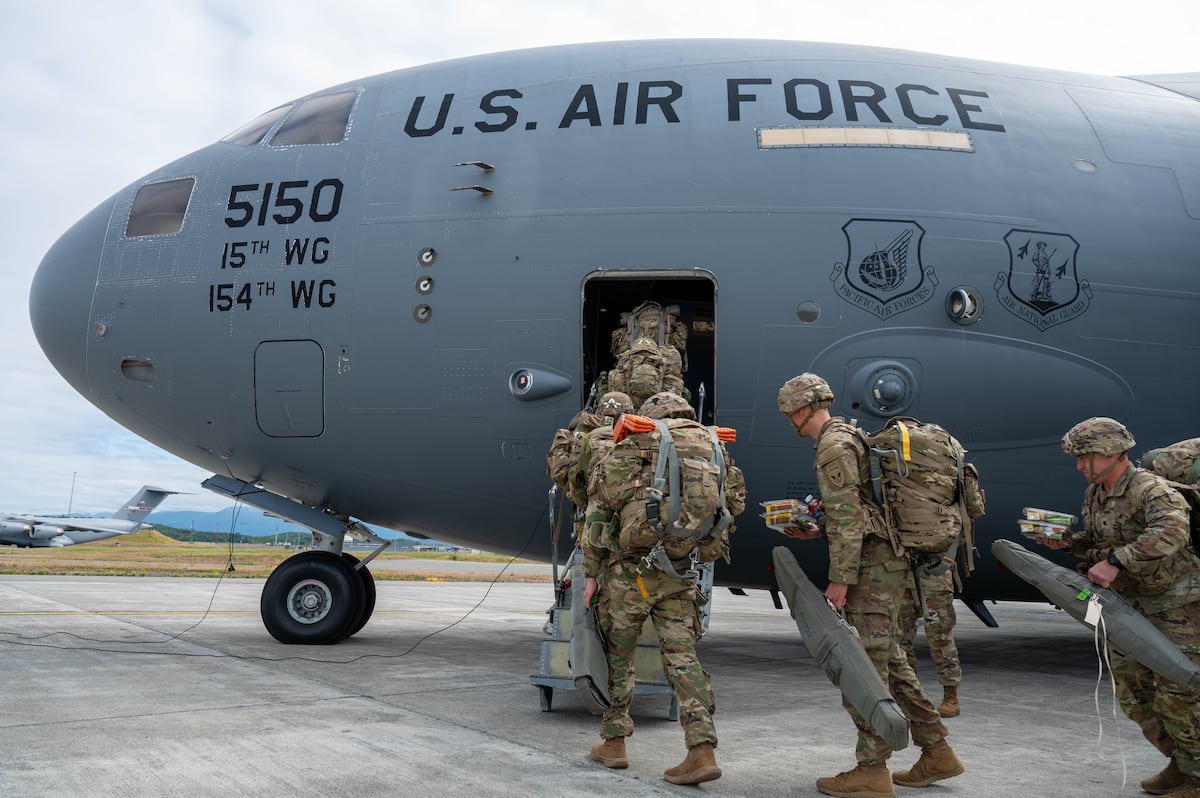



TOWNSVILLE, Australia — U.S. paratroopers made the most dramatic entrance possible to Australia during Exercise Talisman Sabre 2025. Flying 14.5 hours nonstop from Joint Base Elmendorf-Richardson in Alaska, they parachuted from the night sky into the Australian countryside on July 14.
“We landed right on the X,” Col. Brian Weightman, commander of the 2nd Infantry Brigade Combat Team (Airborne) of the U.S. Army’s 11th Airborne Division, told Defense News during an interview in Townsville.
The commander said he was the first to jump onto the drop zone.
In such a parachute operation, casualties of up to 10% are anticipated, he explained.
“We’re very comfortable with that if we land and 90% of the force is able to continue on,” Weightman said.
Luckily, this nighttime airdrop resulted in only three minor injuries, one of which was caused by a midair parachute entanglement in the dark.
Their 6,800-mile flight was only the beginning of the unit’s simulated joint forcible entry operation. After landing, the paratroopers from the 3rd Battalion, 509th Parachute Regiment – nickname “Three Geronimo” – proceeded to march another 30-plus miles to seize an urban objective located near Townsville in northern Queensland.
“To be able to do that with real violence and at speed is really impressive, and I think it should scare adversaries,” the commander said.
Six C-17A Globemaster III aircraft – four from the U.S. Air Force and two from Australia – transported 323 American and a dozen German paratroopers on the intercontinental flight, while French troops joined the sky train upon their arrival Down Under. The C-17s also dropped heavy equipment such as HMMWVs.
Weightman relayed how he enjoyed continuous communications to higher headquarters with voice, data and video from his aircraft. This high bandwidth is a big deal, as it “gives you a lot better situational awareness and a lot better understanding of what’s going on. You’re able to really paint a much better picture of the enemy.”
Furthermore, “To be able to directly deliver an infantry battalion with its command that is situationally aware and physically optimized onto a drop zone 7,000 miles away, means that you can really go anywhere in the world.”
Asked whether nighttime parachute jumps are more challenging, Weightman responded, “For us it’s not much more. You know, we own the night, so once we get on the drop zone, we have an asymmetric advantage against our adversaries.”
Talisman Sabre is meant to showcase interoperability, which is “easy to talk about but hard to do,” according to the colonel.
Nighttime jumps demonstrate “the highest level of proficiency,” he said.
After refitting in Townsville, more than 400 American paratroopers were to join 100 German and 36 French soldiers to perform another nighttime jump on July 21, this time at Shoalwater Bay in central Queensland.
“This airfield seizure and expanded lodgment is very classic – it’s the bread and butter of the airborne infantry,” Weightman noted.
The 11th Airborne Division possesses two of the U.S. Army’s five airborne brigades: the 1st Brigade is a mobile combat brigade equipped with Infantry Squad Vehicles, while 2nd Brigade is airborne. Asked what his division brings, Weightman highlighted two things – the ability to move anywhere in the Indo-Pacific, and the other is its Arctic mission.
“We’re the only brigades in the world that have the ability to conduct offensive operations in the Arctic,” the commander said. The troops can operate in arctic climates or the subtropics of Australia with equal adeptness.
Defense News asked whether there is still a place for airborne units on modern battlefields. After all, Russia’s airmobile operation at Hostomel Airport at the start of its invasion of Ukraine in February 2022 ended disastrously.
“I would argue, yes,” Weightman responded. “And as I’m looking from the enemy’s perspective, what we’re able to do would absolutely scare me if I was the enemy of our country.”
The Indo-Pacific region is rife with tensions – China, Taiwan, the Korean Peninsula – and the 11th Airborne Division is ready to accomplish offensive, defensive, stability or expeditionary operations, said the brigade commander.
Asked about the rising threat from China, Weightman responded, “You know, we’re not training against a specific adversary. What we’re training to do is to be interoperable with our allies and partners in the Indo-Pacific.”
However, he continued, “If we’re able to do that and mass power from anywhere to anywhere at scale, then we should be able to beat any adversary and keep the Indo-Pacific region open.”
The exercise was the eleventh iteration of Talisman Sabre. The drill involved more than 40,000 troops from 19 nations.
Gordon Arthur is an Asia correspondent for Defense News. After a 20-year stint working in Hong Kong, he now resides in New Zealand. He has attended military exercises and defense exhibitions in about 20 countries around the Asia-Pacific region.
